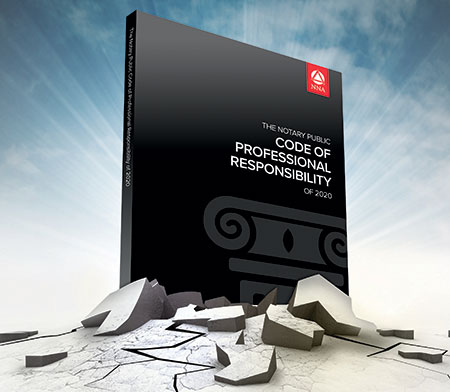
Guiding Principle VI of The Notary Public Code of Professional Responsibility of 2020 is concerned with the Notary’s use and protection of an official seal. It reads, “The Notary shall affix or attach an official seal to every notarial certificate and not allow the seal to be used by another.”
The Code requires every Notary to use a seal for many practical reasons:
- The Notary seal provides a visual assurance — and if an embosser is used, a tangible assurance — to all persons relying on a document that the Notary has lawfully performed the notarial act.
- The Notary seal contains information allowing the Notary’s credentials as a trustworthy and duly appointed officer of the state to be verified.
- The formality of affixing the Notary seal provides the signing parties with a sense of closure to the notarial transaction.
- The presence of a Notary seal on a document can discourage and allow detection of document frauds.
- The presence of a Notary seal enables a document to be entered into evidence in court without further proof under the federal and many states’ rules of evidence.
- The electronic Notary seal can be affixed using technology that will display evidence of any attempt to change the document.
In short, whether a notarized document is paper or electronic, the presence of a Notary seal engenders trust in the integrity of the notarization.
Given these practical benefits, the Code contains several standards for the proper use and security of the seal. No individual but the Notary may use a Notary’s seal, and the Notary must never delegate the responsibility of affixing the seal (VI-A-2). The Notary must safeguard and maintain sole control of the seal (VI-B-1). Surrendering the seal to an employer at the termination of employment is prohibited (VI-B-2). Finally, the Notary must destroy, disable, delete, or erase the seal when the Notary’s term of office expires or is resigned or revoked (VI-B-3).
The Notary seal has a long and rich history. Once upon a time, a seal was affixed by a metal implement impressed upon wax that was first pooled upon the document. Wax seal impressions eventually gave way to metal embossers that crimped impressions on the paper itself, which in turn were replaced or supplemented by photographically reproducible images stamped on documents with rubber seals. Today, electronic Notary seals affixed or attached to electronic documents using modern technology enhance confidence in twenty-first century e-commerce transactions.
Although Notary seals have evolved over time, one thing has never changed: the universal recognition of the Notary seal as the official insignia and symbol of the Notary Public office. Therefore, even if the average person on the street does not fully understand what Notaries do, they immediately know a Notary seal when they see one.
Bill Anderson is the NNA’s Vice President of Government Affairs and Drafting Coordinator for The Notary Public Code of Professional Responsibility of 2020.